




How to Apply the Tangent Secant Theorem in Problem Solving
The tangent-Secant Theorem formula is a fundamental tool of Geometry found in Euclid’s Elements book. There are many methods to prove the theorem. Most important is using similar triangles. So, in this article, we will be discussing the proof of the Theorem in detail and its applications.
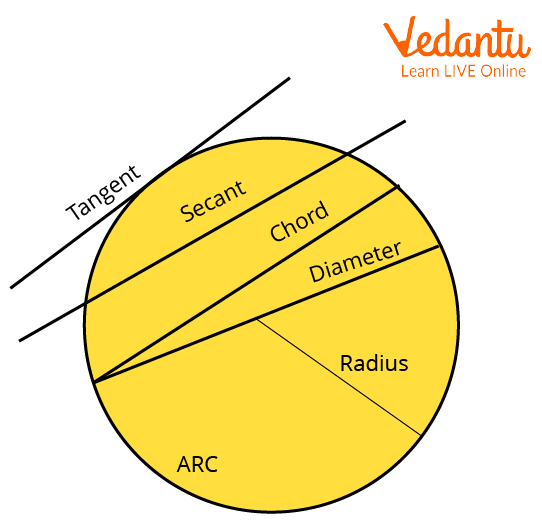
Terms Associated with Circle
History of Euclid
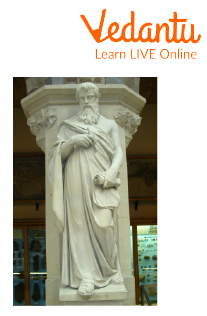
Euclid
Name: Euclid
Born: Mid-4th century BC
Died: Mid-3rd century BC
Field: Mathematics
Nationality: Greek
Statement of Tangent-Secant Theorem
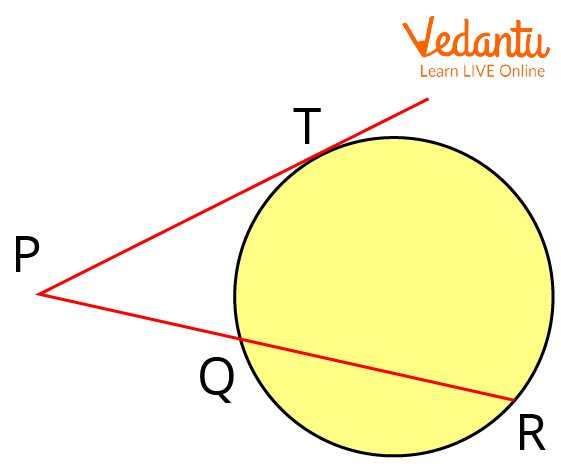
Circle with PT tangent and PQR secant
For a circle with centre O, consider PT to be the tangent to the circle at the point from external point P and PQR to be the secant to the circle with points Q and R on the circle, then Tangent-Secant Theorem is defined as:
$P Q \times P R=P T^{2}$
Proof of Secant Tangent Theorem
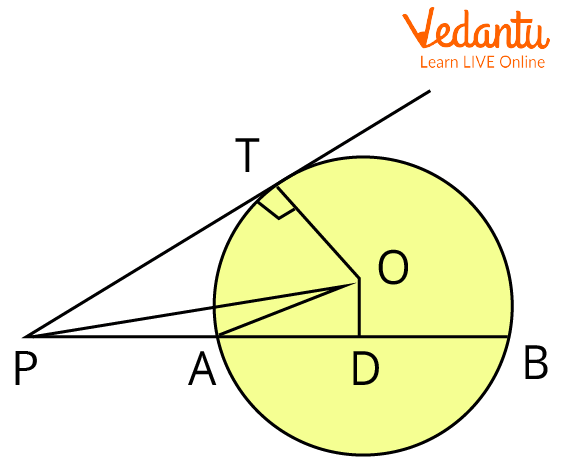
Proof of the Tangent Secant Theorem
Given: PAB is secant to the circle with centre 0 and radius r. PT is tangent to the circle.
To prove: $P A \times P B=P T^{2}$
Construction: Draw $O D \perp A B$. Join $O P, O T$, and $O A$.
Proof:
Since $O D \perp A B$
$\therefore A D=D B \ldots(1)$ (Perpendicular from the centre to the chord bisects the chord)
$P A \times P B=(P D-A D)(P D \div B D)$
$\Rightarrow P A \times P B=(P D-A D)(P D+A D) \quad$ (Using 1)
$\Rightarrow P A \times P B=P D^{2}-A D^{2}$
In right $\triangle O P D$,
$O P^{2}=O D^{2}+P D^{2}$
$\Rightarrow P D^{2}=O P^{2}-O D^{2}$
$\therefore P A \times P B=\left(O P^{2}-O D^{2}\right)-A D^{2}$
$\Rightarrow P A \times P B=O P^{2}-\left(O D^{2}+A D^{2}\right)$
In right $\triangle O A D$,
$O A^{2}=O D^{2}+A D^{2}$
$\therefore P A \times P B=O P^{2}-O A^{2}$
$\Rightarrow P A \times P B=O P^{2}-O T^{2} \quad(\because O A=O T)$
In $\triangle O P T$,
$O P^{2}=P T^{2}+O T^{2}$
$\Rightarrow O P^{2}-O T^{2}=P T^{2}$
$\therefore P A \times P B=P T^{2}$
Hence proved.
Limitations of Tangent-Secant Theorem
The tangent-Secant theorem doesn’t give any idea if the secant and tangent are not drawn from common points.
Tangent-Secant Theorem is only applicable in the case of 2-dimensional circles and not in 3-dimensional figure spheres.
Applications of Tangent-Secant Theorem
Tangent-Secant Theorem is of great significance. It is used in our day-to-day life such as school buildings, bridges, monuments etc.
Monuments such as the Statue of Liberty and Pyramids are also based on concepts of secants and tangents.
Solved Examples
1. In the given figure, $P Q=12 \mathrm{~cm}, P T=24 \mathrm{~cm}$, then find $R Q$.
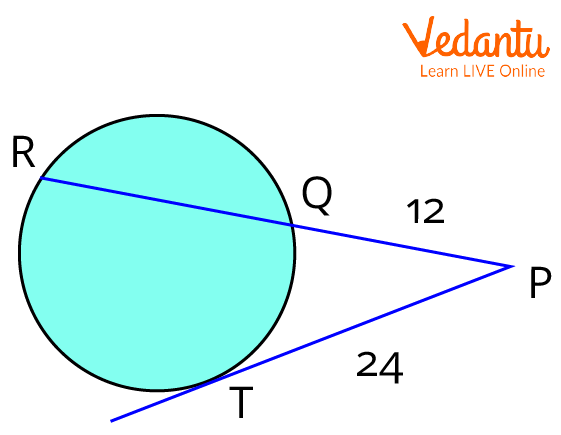
PQ and Tangent PT is given
Ans:
Using Tangent Secant Theorem, we have
$P Q \times P R=P T^{2}$
Putting values, we get
$(12+x) \times 12=24^{2} \\$
$\Rightarrow(12+x) \times 12=576 \\$
$\Rightarrow(12+x)=48 \\$
$\Rightarrow x=48-12 \\$
$\Rightarrow x=36$
So, we get
$R Q=36 \mathrm{~cm}$
2. In a circle, the tangent is drawn from outside point $P$ to the circle at point $T$ and from the same point secant is drawn to the circle intersecting the circle at $Q$ and $R$, respectively, such that $P Q=25 \mathrm{~cm}, R Q=9 \mathrm{~cm}$, then find $P T$.
Ans:
According to the question, we get the following figure:
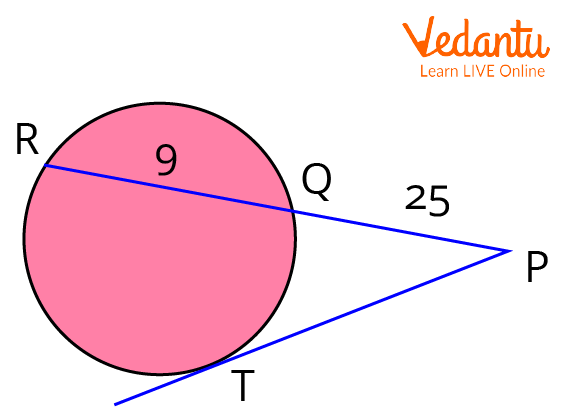
Secant PQR is given
Using Tangent Secant Theorem, we have
$P Q \times P R=P T^{2}$
Putting values, we get
$(25+9) \times 25=P T^{2} \\$
$\Rightarrow P T^{2}=34 \times 25$
$\Rightarrow P T^{2}=850 \\$
$\Rightarrow P T=\sqrt{850} \\$
$\Rightarrow P T=29.154$
So, we get
$P T=12.154 \mathrm{~cm}$
3. In the given figure, $P R=84 \mathrm{~cm}, P T=42 \mathrm{~cm}$, then find $R
Q$.
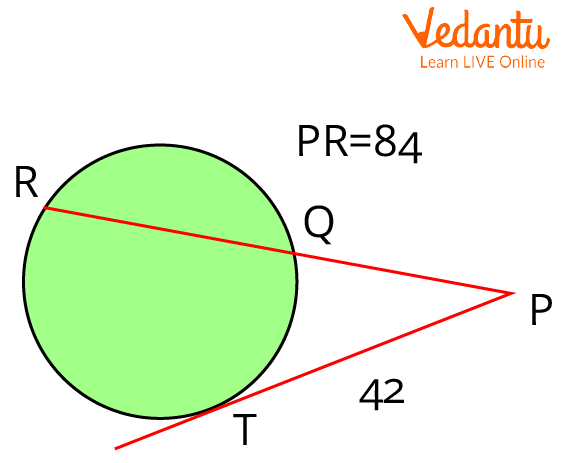
Secant and tangent from a point are given
Ans:
Using Tangent Secant Theorem, we have
$P Q \times P R=P T^{2}$
Putting values, we get
$P Q \times 84=42^{2} \\$
$\Rightarrow P Q \times 84=1764 \\$
$\Rightarrow P Q=21$
Now,
$R Q=P R-P Q$
And,
$P Q=21 \\$
$\Rightarrow R Q=84-21 \\$
$\Rightarrow R Q=63 \mathrm{~cm}$
Important Formulas to remember
$P Q \times P R=P T^{2}$, where $\mathrm{PT}$ is tangent and $\mathrm{PQR}$ is secant to the circle with centre $O$ and radius $r$.
Important Points to Remember
A Tangent line touches the circle at only one point.
A Secant line touches the circle at exactly two points.
Conclusion
In the article, we have discussed the proof of the Tangent-Secant Theorem and its applications in detail. The Tangent Secant Theorem helps us in solving mathematical problems. In the world of art, architecture, and the growing demands of infrastructure, the tangent secant theorem places itself at the centre of its applications. In all, we can say that the theorem is of great importance.
FAQs on Tangent Secant Theorem Explained
1. What is the Tangent-Secant Theorem as per the CBSE Class 10 syllabus?
The Tangent-Secant Theorem states that if a tangent segment and a secant segment are drawn to a circle from an exterior point, then the square of the length of the tangent segment is equal to the product of the lengths of the external secant segment and the entire secant segment. For a tangent from point P touching the circle at A, and a secant from P intersecting the circle at B and C, the formula is PA² = PB × PC.
2. What is the main difference between a tangent and a secant of a circle?
The primary difference lies in how they interact with a circle:
- A tangent is a line that touches the circle at exactly one point, known as the point of tangency.
- A secant is a line that intersects or cuts the circle at two distinct points. A chord is the segment of the secant that lies inside the circle.
Essentially, a tangent just grazes the circle, while a secant passes through its interior.
3. What is the formula used in the Tangent-Secant Theorem and what do the variables represent?
The formula for the Tangent-Secant Theorem is PA² = PB × PC. In this formula:
- P is the external point from which the tangent and secant are drawn.
- PA is the length of the tangent segment from the external point P to the point of tangency A.
- PB is the length of the external part of the secant segment, from point P to the first intersection point B on the circle.
- PC is the length of the entire secant segment, from point P to the second intersection point C on the circle.
4. How does the Tangent-Secant Theorem differ from the Secant-Secant Theorem?
Both theorems relate to segments drawn from an external point to a circle, but they apply to different combinations of lines. The key difference is:
- Tangent-Secant Theorem: Involves one tangent and one secant. The relationship is PA² = PB × PC.
- Secant-Secant Theorem: Involves two secants drawn from the same external point. If one secant intersects the circle at A and B, and the other at C and D, the relationship is PA × PB = PC × PD.
The Tangent-Secant Theorem can be seen as a special case of the Secant-Secant Theorem where the two intersection points of one secant become a single point of tangency.
5. What is the importance of the Tangent-Secant Theorem in solving geometry problems?
The Tangent-Secant Theorem is a powerful tool for finding unknown lengths in geometric figures without needing to know angles or the circle's radius. Its importance lies in its ability to establish a direct algebraic relationship between segments. It is frequently applied in NCERT and CBSE board exam problems to solve for missing lengths in complex diagrams involving circles, and it forms a foundational concept for more advanced geometry, such as in engineering or design applications where circular shapes are involved.
6. What is the underlying geometric principle that proves the Tangent-Secant Theorem?
The proof of the Tangent-Secant Theorem is fundamentally based on the concept of similar triangles. By drawing chords within the circle (for instance, AC and AB), we can prove that the triangle formed by the external point, the point of tangency, and one intersection point (e.g., ΔPAC) is similar to the triangle formed by the external point and the other two points (e.g., ΔPBA). The similarity of these triangles (ΔPAC ~ ΔPBA) leads to the proportional relationship of their corresponding sides, which simplifies to the theorem's formula: PA² = PB × PC.
7. How is the 'Power of a Point' theorem related to the Tangent-Secant Theorem?
The 'Power of a Point' Theorem is a more general concept that unifies three related scenarios for a point P and a circle: when P is outside, on, or inside the circle. The Tangent-Secant Theorem is essentially one specific case of the Power of a Point Theorem—the case where the point P is outside the circle. The 'power' of point P is a constant value, which for an external point equals PA² (for a tangent) and PB × PC (for a secant). This theorem shows they are all expressions of the same underlying geometric property.
8. What is the 'Angle of a Tangent and a Secant Theorem' and how is it different?
This is a different but related theorem that deals with angles, not lengths. The theorem states that the measure of the angle formed by a tangent and a secant drawn from an external point to a circle is half the difference of the measures of their intercepted arcs. For example, if the tangent and secant from point P intercept a larger arc (far arc) and a smaller arc (near arc), the angle at P is calculated as: ∠P = ½ (measure of far arc - measure of near arc). This theorem focuses on angles, while the Tangent-Secant Theorem focuses on segment lengths.








































